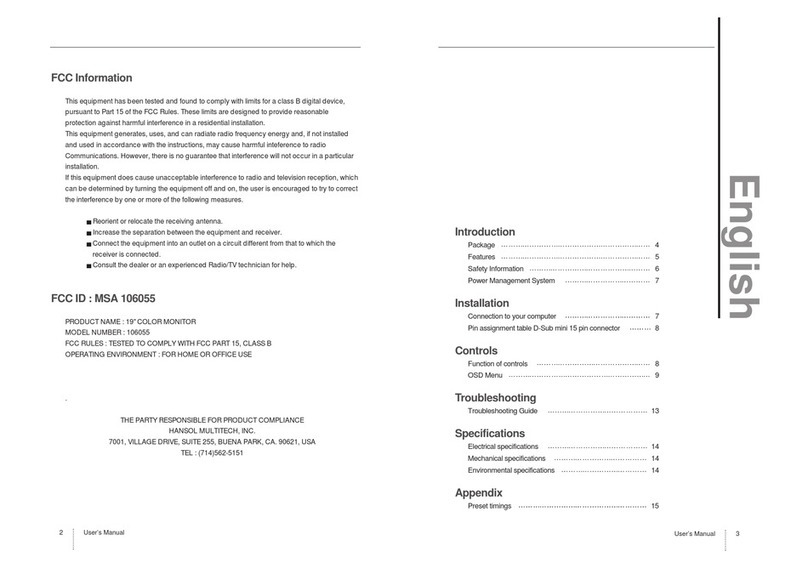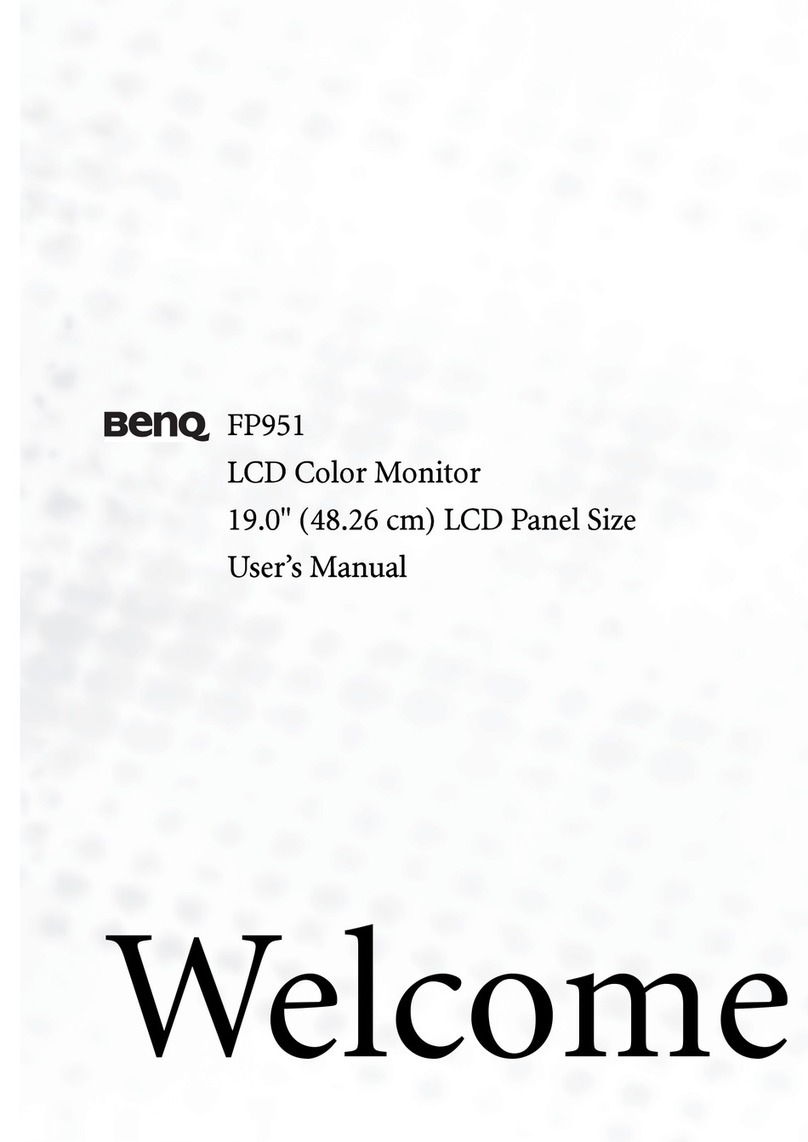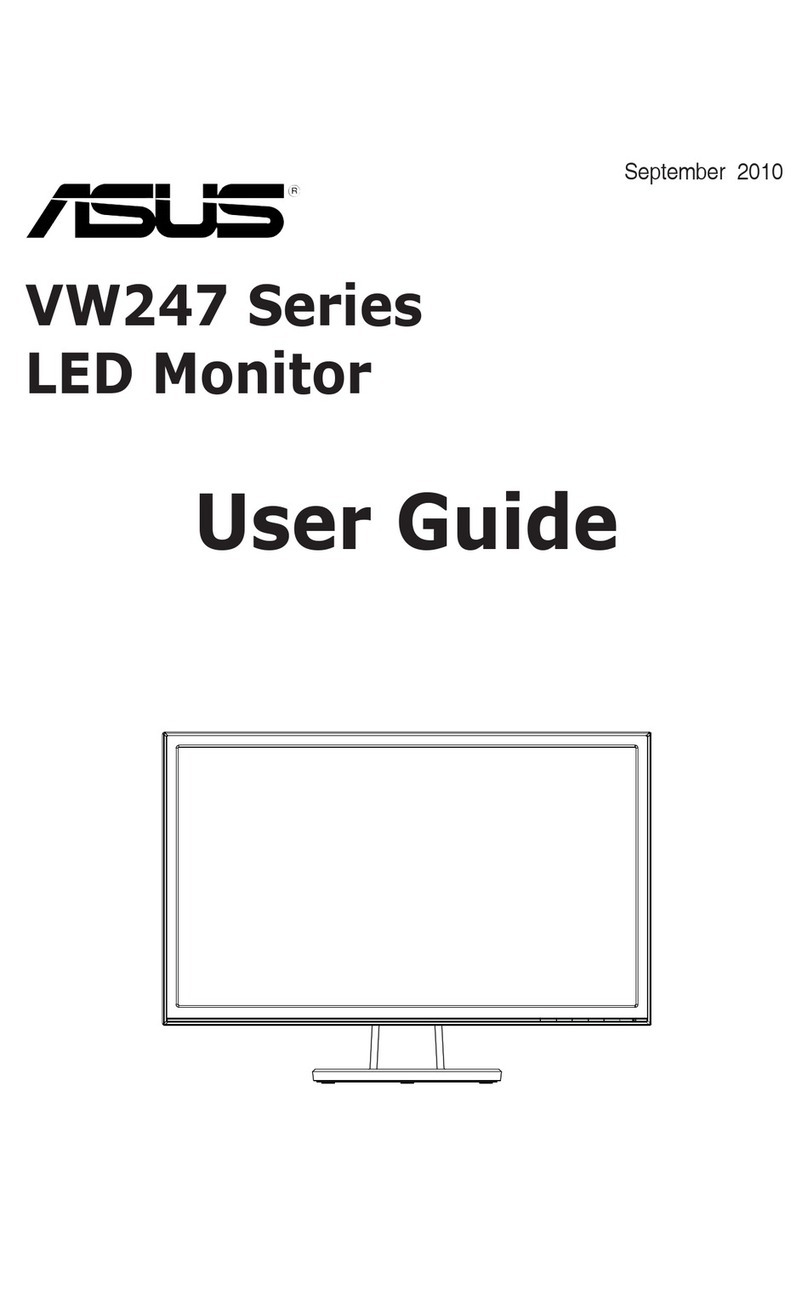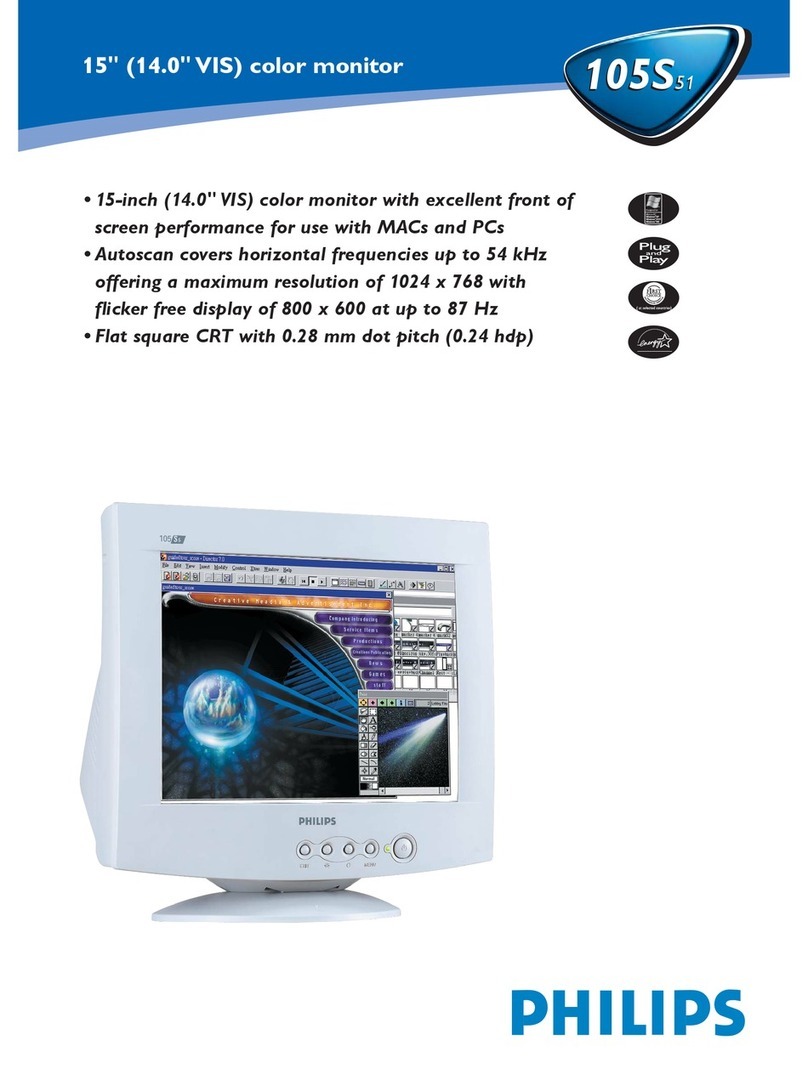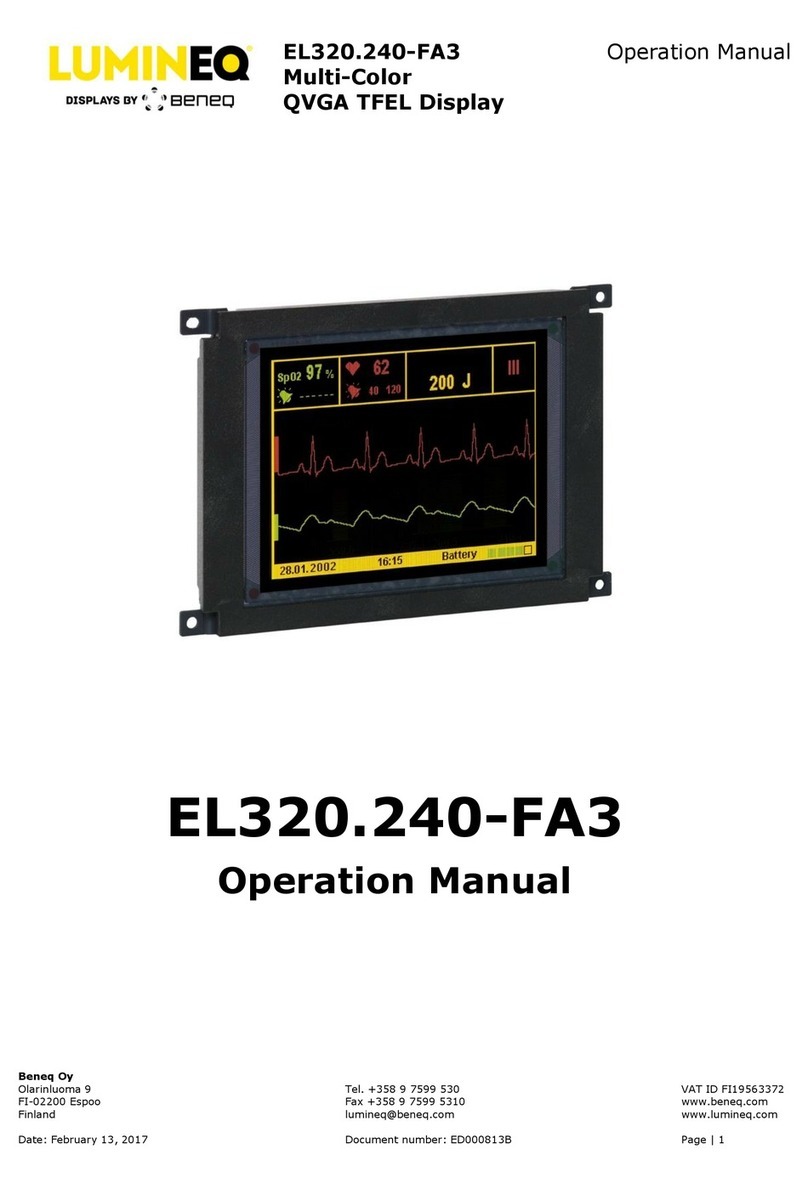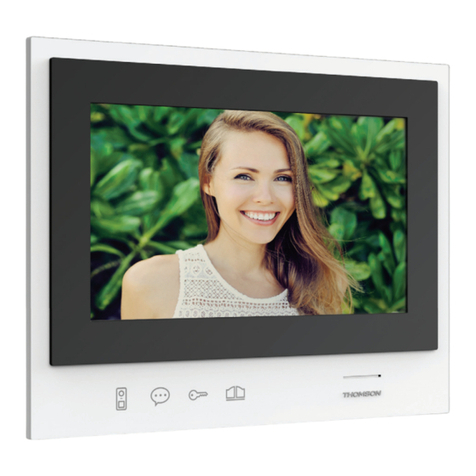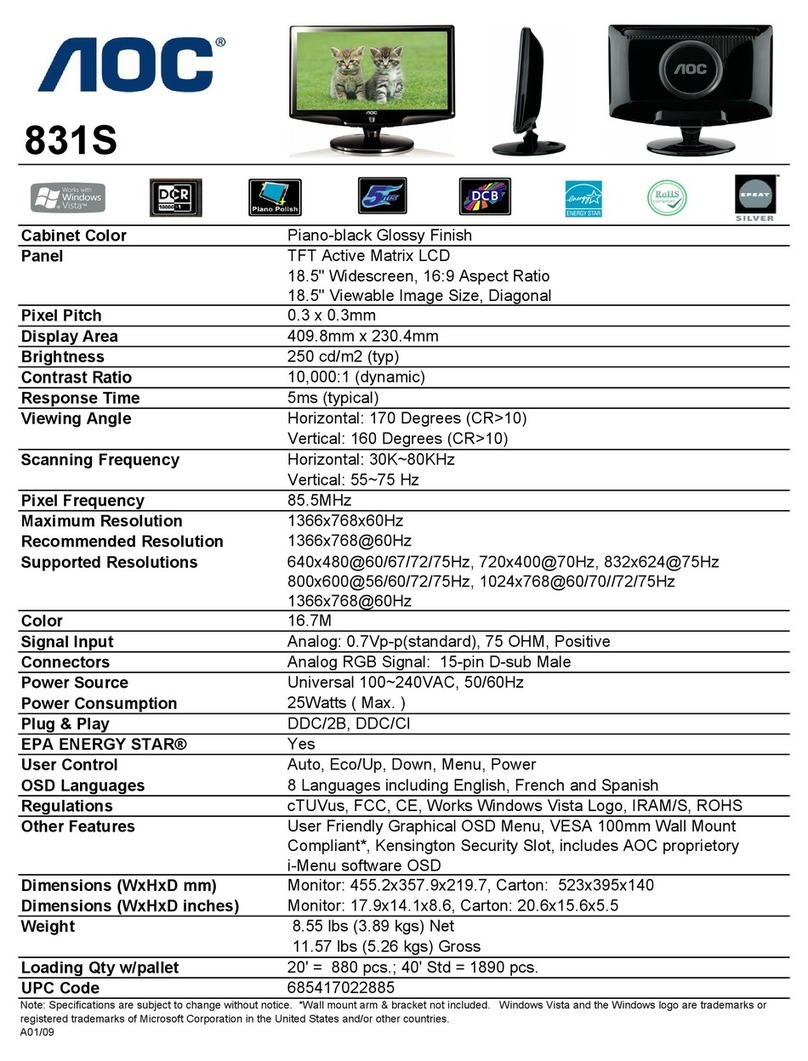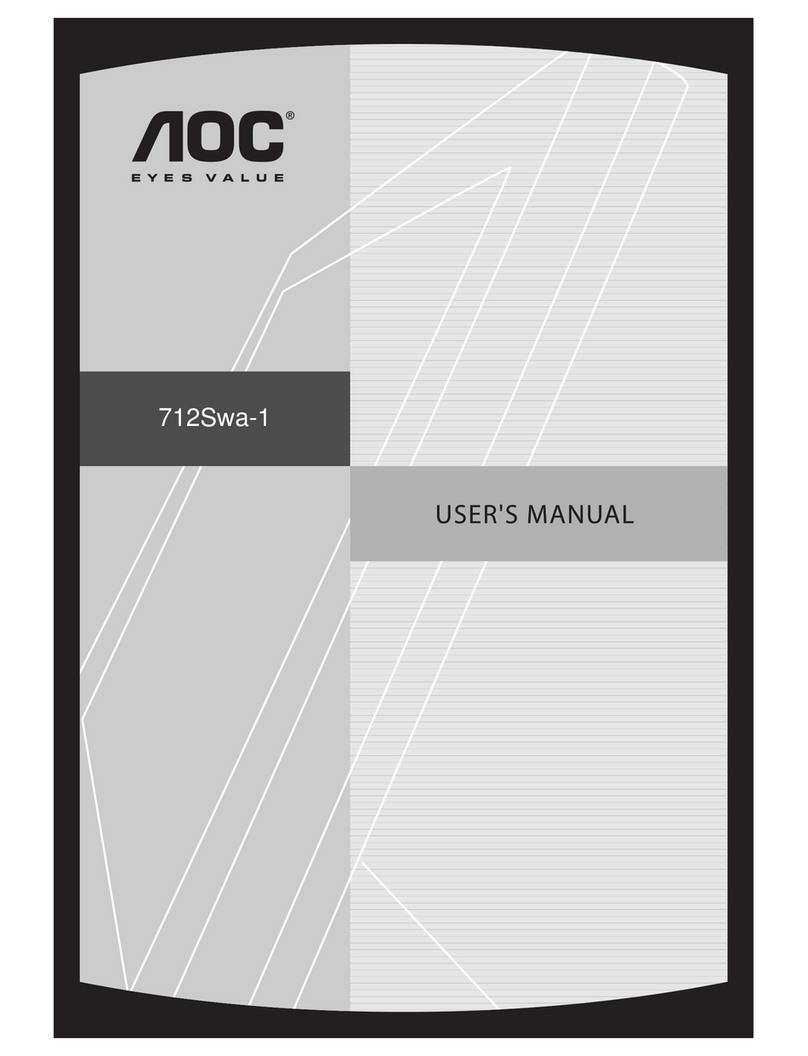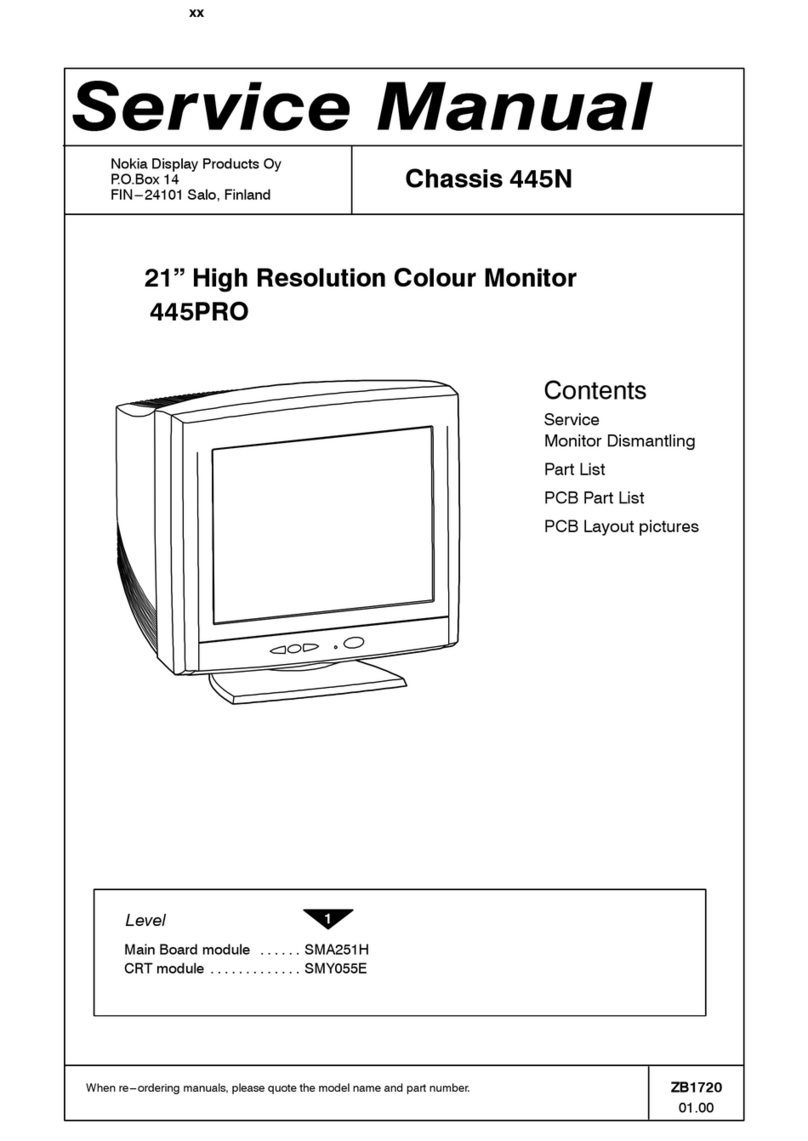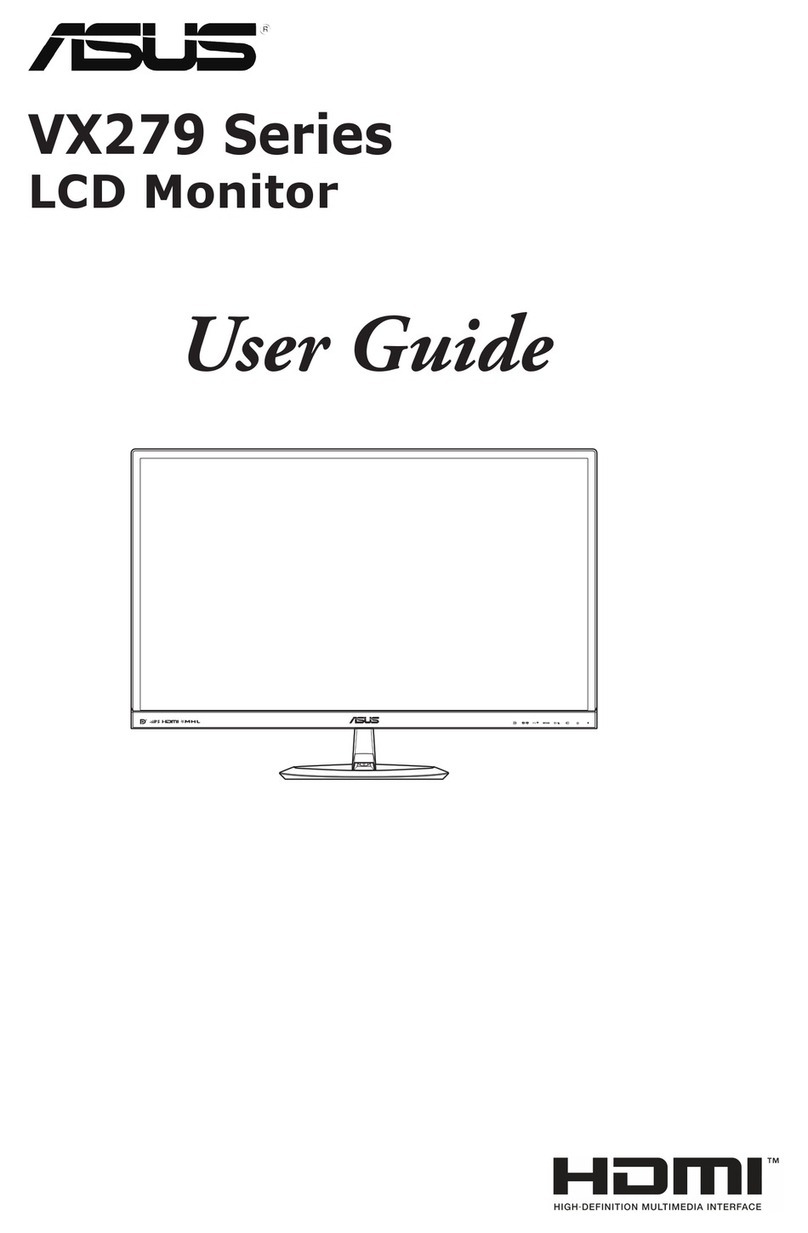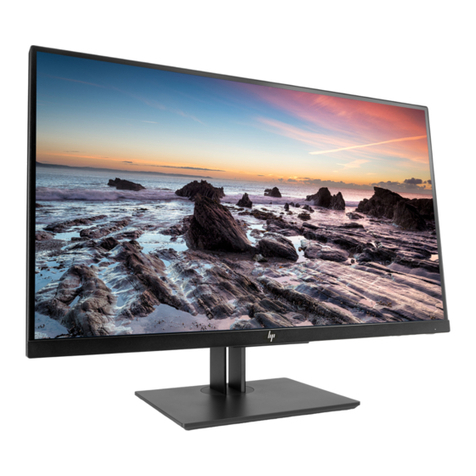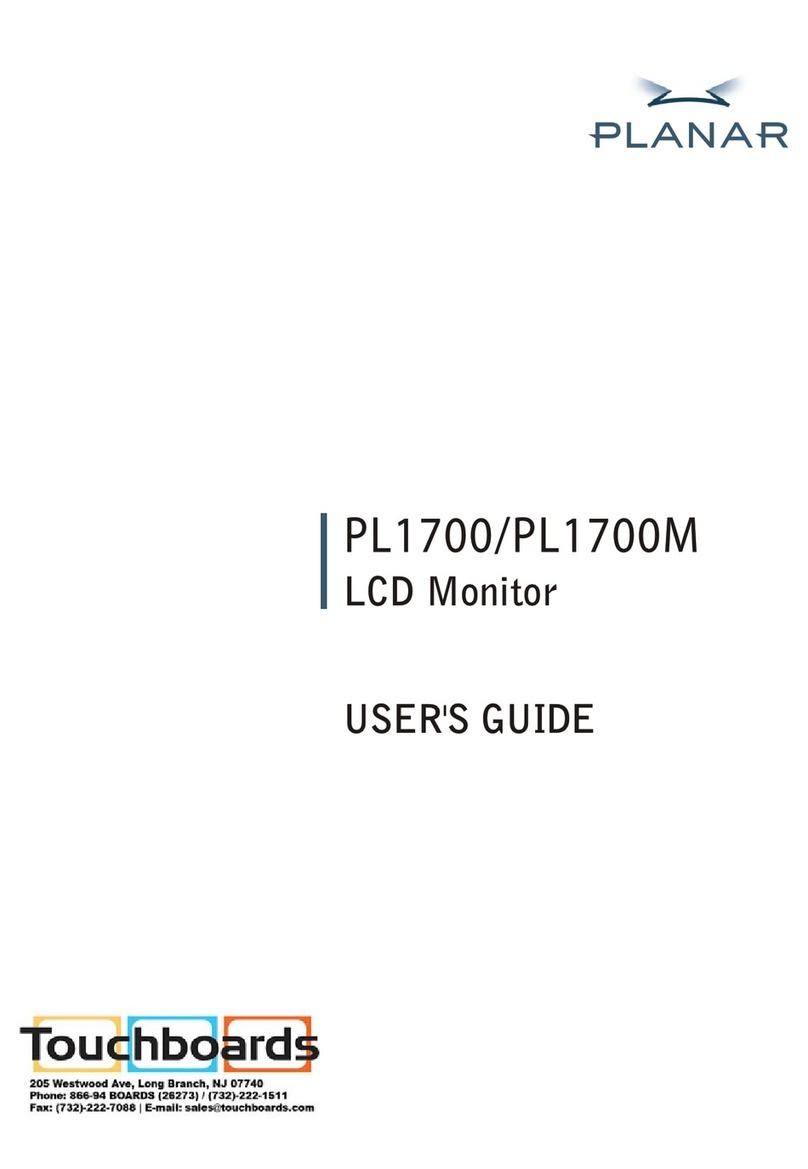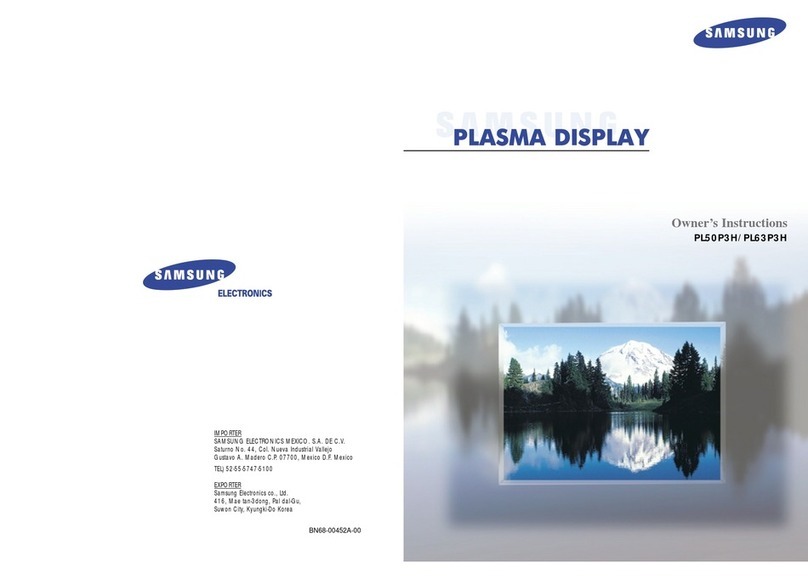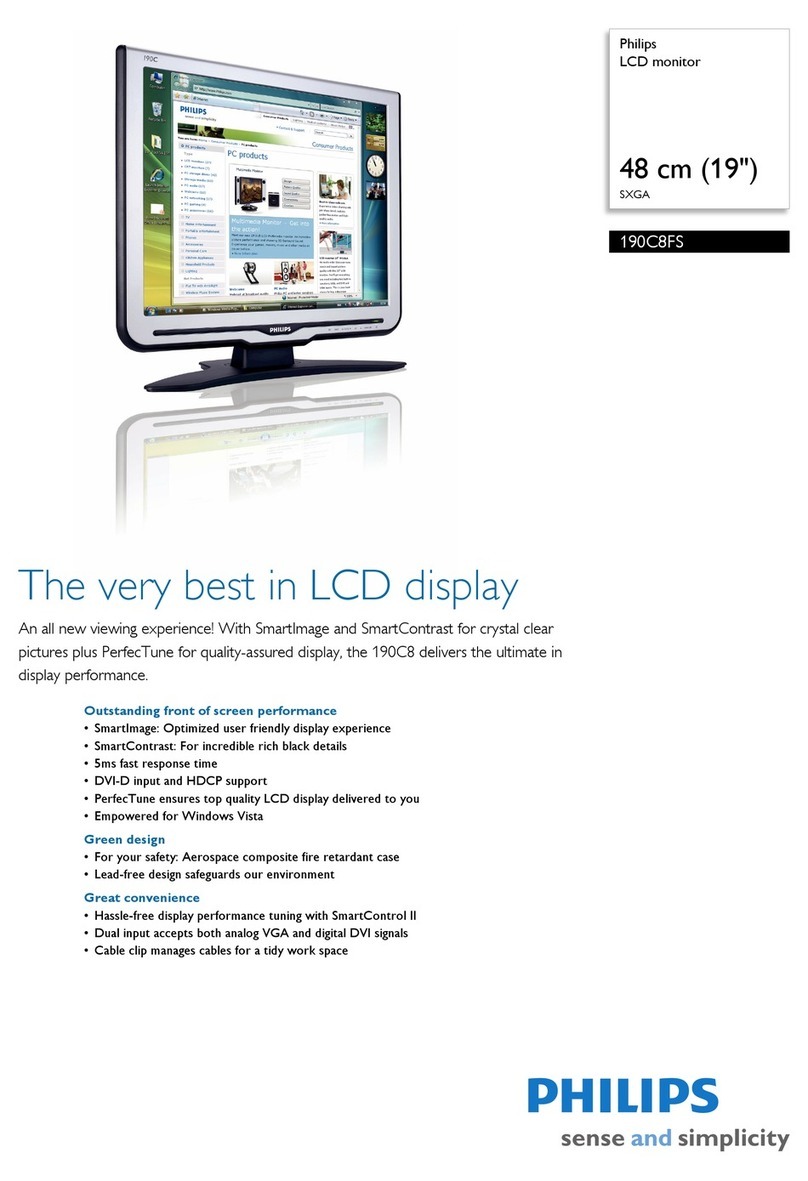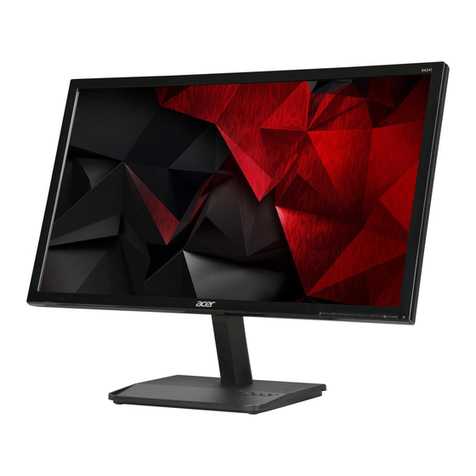BELINEA 103026 User manual


_
Belnea
Service
Manual
17-inch
Color
Monitor
(Belinea
103026)

Belnea
(Maxdata
103026)
Table
of
Contents
Eg.
SPRCCAUUONS
,
atseatsc
ices
rere
tacv
eat
elkan
ea
uaa
roe
ane
naaaeuinne
ne
2
2m
“PYOUUCL
SPEClICALLOUS
4
wtiet,
dais
soisacse
ii
caeay
oh
ack
date
yaeaen
eaumiaaesecnetaaienyiie?
=)
S:.
“Control
Location
and
PunChONS
iacc.wicictaannmnueaatinerneniieqemtantindes
6
Ae
OPS
TALON
ECOL.
saaycscans
dost
co
ecasera
Seatac
a
dcttaueee
cle
teas
th
teapot
eessapind
eveaeiacuemaeee
11
3
5...
Alignments
anid
Agjustents
acess
ccscasajasescecitsatvelniaistaadtacmatnaqencenteeniacnnsh
16
G:.
“TPOUDISSHOOUING
4.
ecesyschssccsstexsatssesiezmsancsanuadistaeaiatanasremeaersticerenasseneentaaising
20
Te
(“Recommended
Spare
Pars
List
visceon
cor
tient
nis
oie
ke
eta
Reeth,
26
Bes
BLOCK
A
raat
yc
ssigsss
Sie cag
iascctes
8
ae
as
card
sees
apemas
ener
esata
goods
adden
cas
ate
eieanye
SEES
28
,
9,
Exploded
DIA
Grams:
sitet.
nace
ier
aviorscenmis
apni
iemsinie
aaa
etiias
Inserted
|
TPO
e
aR
CS
Dra
B
PARIG.
spe
stead
eae
ences
eae
erode
savaapeata
tesenaseraeaseattciinedcunnnteaaatsibetanss
Inserted
11.
Schematic
Diagrams
,
iaass
gla
Wie
beti
venetet
iiss
blaaeie
tin
cubes
Satin
tabs
alandins
Inserted
Pagel
|

Sev
a
ec
SCP
RT
on
Ce
RN
TEA
Belnea
1
Precautions
(Maxdata
103026)
Follow
these
safety
and
servicing
precautions
to
prevent
damage
and
to
protect
against
potential
hazards
such
as
electrical
shock
and
X-rays.
1-1
Safety
Precautions
j-
1.
1-1
Warnings
For
safety
purpose,
do
not
attempt
to
modify
the
circuit
board,
and
always
disconnect
the
AC
power
before
performing
servicing
on
the
monitor.
.
Operation
of
the
monitor
outside
its
cabinet
or
with
the
cover
removed
involves
the
risk
of
shock
hazard.
Repair
work
on
the
monitor
should
only
be
attempted
by
service
personnel
who
are
thoroughly
familiar
with
all
necessary
safety
precautions
and
procedures
for
working
on
high
voltage
equipment.
.
Do-not
lift
the
CRT
by
the
neck.
After
completely
discharging
the
high
voltage
anode,
handle
the
CRT
only
when
wearing
shatterproof
goggles.
Try
to
keep
the
CRT
away
from
the
body
during
handling.
.
High
voltage
should
always
be
kept
at
the
rated
value,
no
higher.
Only
when
high
voltage
is
excessive
are
X-rays
capable
of
penetrating
the
shell
of
the
CRT.
Operation
at
high
voltages
may
also
cause
failure
of
the
CRT
or
high
voltage
circuitry.
.
The
CRT
is
especially
constructed
to
limit
X-
ray
emission
to
0.5mR/HR
at
300
microamperes
anode
current.
To
ensure
continued
X-ray
protection,
replace
the
CRT
with
only
the
same
or
equivalent
type
as
the
original,
and
adjust
the
anode’s
voltage
to
the
designated
maximum
rating,
never
to
exceed.
1-1-2
Safety
Checks
Before
returning
the
monitor
to
the
user,
perform
the
following
safety
checks:
1.
Inspect
to
make
certain
that
each
lead
dress
is
not
pinched
or
that
hardware
is
not
lodged
between
the
chassis
and
other
metal
parts
in
the
monitor.
.
Inspect
all
protective
devices
such
as
nonmetallic
control
knobs,
insulating
materials,
cabinet
backs,
adjustment
and
compartment
covers
or
shields,
isolation
resistor-capacitor
networks,
mechanical
insulators,
etc.
.
AC
Leakage
Current
Check
Always
perform
the
AC
Leakage
Current
Check
on
the
exposed
metal
parts,
including
metal
cabinets,
screwheads
and
control
shafts,
as
follows:
a)
Plug
the
AC
line
cord
directly
into
a
rated
AC
outlet.
Do
not
use
an
isolation
transformer
during
the
check.
b)
Use
an
AC
voltmeter
with
at
least
5000
ohms
per
volt
sensitivity
as
follows:
Connect
a
1500
ohms,
10
watt
resistor
paralleled
by
a
0.15uF
AC
capacitor
in
series
with
all
exposed
metal
cabinet
parts
anda
known
earth
ground,
such
as
electrical
conduct
or
electrical
ground
connected
to
earth
ground,
as
shown
in
the
Figure
1-1.
Measure
the
AC
voltage
across
the
combination
of
resistor
and
capacitor.
Figure
1-1.
Set
Up
For
AC
Leakage
Current
Check
To
exposed
meatal
cabinet
part
To
known
earth
ground
4500
ohm
10
watt
c)
Reverse
the
AC
plug
at
the
AC
outlet
and
repeat
the
steps
for
AC
voltage
measurements
for
each
exposed
metal
part.
d)
Voltage
reading
must
not
exceed
0.3
volts
RMS,
equivalent
to
0.2
milliampere
AC.
Any
value
exceeding
this
limit
ill
constitute
a
potential
shock
hazard
and
must
be
corrected
immediately.
Page
2
Precautions

Belnea
(Maxdata
103026)
1-1-3
Product
Safety
Notices
Many
electrical
and
mechanical
parts
in
this
chassis
have
special
safety-related
characteristics
which
are
often
not
evident
from
visual
inspection,
the
protection
afforded
by
them
may
not
be
obtained
by
replacing
them
with
components
rated
for
higher
voltage,
wattage,
etc.
Before
replacing
any
of
these
components,
consult
the
Recommended
Spare
Parts
List
given
at
the
end
of
this
manual.
Any
of
the
replacements
that
do
not
provide
the
same
safety
characteristics
may
result
in
shock,
fire,
X-ray
emission
or
other
hazards.
1-2
Servicing
Precautions
Warning:
An
electrolytic
capacitor
installed
with
the
wrong
polarity
might
explode.
Caution:
Before
performing
servicing
covered
by
this
service
manual,
read
and
follow
the
Safety
Precautions
section
of
this
manual.
Note:
If
unforeseen
conflict
between
the
following
servicing
precautions
and
any
of
the
safety
precautions,
always
follow
the
safety
precautions
1.
Follow
closely
the
servicing
precautions
printed
on
the
monitor
cabinet
and
chassis.
2.
Always
unplug
the
AC
power
cord
from
the
AC
power
source
before
removing
or
installing
any
component
ot
assembly,
disconnecting
PCB
plugs
or
connectors
and
connecting
a
test
component
in
parallel
with
a
capacitor.
3.
When
replacing
parts
or
circuit
boards,
clamp
the
lead
wires
around
the
component
before
soldering.
4,
When
replacing
a
high
wattage
resistor
(>0.5W
metal
oxide
film
resistor)
in
the
circuit
board,
keep
the
resistor
about
1
cm
(1/2
inch)
away
from
the
circuit
board.
5.
Keep
wires
away
from
the
high
voltage
or
high
temperature
components.
6.
Keep
wires
in
their
original
positions
so
as
to
minimize
interference.
7.
Always
connect
a
test
instrument’s
ground
lead
to
the
instrument
chassis
ground
before
connecting
the
positive
lead;
always
remove
the
instrument’s
ground
lead
last.
After
putting
the
rear
cover
back
and
make
sure
the
monitor
is
working
properly,
the
Hi-Pot
&
Ground
Continuity
tests
MUST
BE
performed
before
the
monitor
is
returned
to
user.
1-3
Hi-Pot
Test
1,
Test
Equipment
Puncture
test
model
PM5530
ADT
or
KIKUSU
TOS-8750
voltage
tester
or
equivalent
approved
equipment.
Note
:
The
test
equipment
must
be
calibrated
in
regular
period.
2.
Test
Setup
a)
Apply
voltage
:
DC
2100
VDC
b)
Test
duration
:
3
seconds
c)
Cutoff
current
should
be
set
to
3
mA
3.
Test
Procedure
a)
Unplug
power
cord
from
AC
source.
b)
Put
the
power
switch
of
the
monitor
in
the
“ON”
position.
c)
Leave
signal
cable
un-connected.
Precautions
Page}
|

Belnea
(Maxdata
103026)
d)
Plug
monitor
power
cord
to
the
Hi
Pot
tester
terminals.
e)
Turn
on
tester
and
watch
the
indicator
or
beeper.
f)
If
the
indicator
lamp
lighten,
or
beeper
beeps,
the
test
fails.
1-4
Ground
Continuity
Test
1.
Test
Equipment
AC
low
ohm
tester
TOS-6100
or
equivalent
approved
equipment.
Note
:
The
test
equipment
must
be
calibrated
in
regular
period.
2.
Test
Setup
a)
Test
duration
:
3
seconds
b)
Set
current
limit
at
25
A
c)
The
grounding
resistance
must
be
less
than
0.1
ohm.
3.
Test
Procedure
a)
Plug
the
monitor
power
cord
to
the
tester
terminals.
b)
Make
sure
all
connections
are
well-contacted.
c)
Turn
on
monitor
power
and
tester
power.
d)
Press
“Test”
button.
.
e)
If
green
light
shows
up,
means
test
OK.
If
red
light
shows
up,
means
test
fails.
f)
Ifthe
Tester
has
a
digital
display,
the
resistance
value
must
not
exceed
0.1
ohm.
Note
:
Be
sure
not
to
touch
the
metal
portion
of
the
signal
cable
head
during
testing.
|
Page
4
Precautions

Belnea
(Maxdata
103026)
2
Product
Specifications
2-1
Specifications
17-inch
(16-inch
Visual
image
area),
sloted
mask,
90
degrees
Picture
Tube
deflection,
dot
type
black
matrix,
medium
short
persistence
phosphor,
dark
tint,
non-glare/
anti-static
screen,
0.28
mm
dot
pitch
s
ing
F
Z
VGA,
Super
VGA,
1024x768@60/70/75/85
Hz
eRRRE
ee
REGUS?
1280x1024@60Hz
Maximum
Resolution
1280
dots
(H)
x
1024
lines
(V)
@60Hz
refresh
rate
Display
Area
306
mm
(H)
x
230
mm
(V)
typical
Display
Characters
80
char.
x
60
rows
on
a
10
x
10
matrix
Display
Colors
Analog
|
ty,
jimited
Colors
Input
Horizontal:
30
to
70
kHz
Frequencies
Vertical
:
50
to
160
Hz
iso
Sk
_[Amfon'07
ven ROB
peeve
=
75
Watts
(maximum)
AC
rated
voltage,
100VAC
to
240VAC
Center
Area
:
<
0.3
mm;
Corner
Area
:
<
0.4mm
Power
On/Off,
Contrast,
Brightness,
Horizontal
Size,
Horizontal
Position,
Vertical
Size,
Vertical
Position,
Pincushion,
Trapezoid,
Rotation,
Color
temperature,
Language,
Display
Frequency,
Degauss,
Recall,
H.
Moire,
V.
Moire
Service
Controls
PWB-1618
PWB-1606
:
power
voltage
adjust
(VR801),
high
voltage
adjust
10
(see
Table
2-2.
Timing
Chart)
Operation
temperature
:
10°C
to
40°C
ambient
Operation
Humidity
:
20%
to
80%
ambient
Storage
temperature
:
-40°C
to
65°C
ambient
Storage
Humidity
:
10%
to
90%
(non-condensing)
Altitude
:
Non
operating
40,000
feet
sea
level
operating
10,000
feet
sea
level
User
Controls
Environmental
Considerations
Note:
Above
specifications
are
subject
to
change
without
prior
notice.
Product
Specifications
Pages
|

|
Belnea
(Maxdata
103026)
2-2
Signal
Cable
Pin
Connections
Table
2-1.
Signal
Cable
Pin
Assignment
feet
dP
Si
reeves
i
sv
>
[orsen
ves
——*idi
CN
Ce
forse
aroma
|
Note*
This
pinis
used
for
selftest
detection.
Connect
this
pin
to
ground
at
the
PC
end.
**
—
For
PC
99:
This
pin
will
provide
+5V
from
PC
side.
a
on
|
ey
a
ae
|
Page
6
Product
Specifications

Belnea
(Maxdata
103026)
2-3
Timing
Chart
This
section
describes
the
timings
that
the
computer
industry
recognizes
as
standard
for
computer-generated
video
signals.
Table
2-2.
Timing
Chart
Pa
Ee
ce
aee
ee
ees
eee
H.
Dots
720
640
640
640
800
800
1024
800
1280
1024
V.
Dots
400
480
480
480
600
600
{|
600
1024
768
|
37.5
H-freq
(kHz)
Syne
Polarity
A
period
us
B
Blking
us
C
Syne
us
D
B.P.
us
E
Active
us
F
FE.P.
us
V-freg
(Hz)
Sync
Polarity
O
Period
ms
P
Biking
ms
Q
Sync
ms
R
B.P.
us
S
Active
us
T
F.P.
us
Seperate
Sync
Horizontal
E
Vertical
.
Video
==
Video
iw
o
J
4
Le
a
H.Parameters:
V.Parameters:
A:
Period
B:
Blanking
Time
G:
Period
H:
Blanking
Time
[
C:
Syne
Width
D:
Back
Porch
L
Sync
Width
J:
Back
Porch
ae
E:
Active
Time
F:
Front
Porch
K:
Active
Time
L:
Front
Porch
Product
Specifications
Page?
}

Belnea
(Maxdata
103026)
2-4
Display
Power
Management
Signal
(DPMS)
Note:
The
monitor
will
be
driven
into
“Power
Saving”
mode
by
the
control
signal
from
the
display
controller,
as
indicated
by
the
amber-color
power
LED.
Table
2-3.
Display
Power
Management
Signal
(DPMS)
State
Power
LED
Cousumption
Light
Active
<
*
For
power
consumption
:
75W
Max.
(@
230V
AC,
preset
size
and
maximum
light
output
condition)
2-5
TCO
Version
(Optional)
The
monitor
meets
the
TCO
95/99,
NUTEK
energy
saving,
electric
and
magnetic
field
requirements.
Also
it
is
compliant
with
TCO
95/TCO
99
labelling
scheme.
The
emission
from
magnetic
and
electric
field
must
comply
with
the
limits
specified
by
the
Swedish
Board
for
Measurement
and
Testing,
commonly
known
as
MPR
1990
recommendations.
These
limits
are
sum-
marized
in
the
Table
2-4.
Table
2-4.
TCO
95
Emission
Requirements
Electrostatic
+/-
500
V
+/-
500
V
Potential
The
monitor
is
designed
with
selected
CRT
and
carefully
routed
wires
around
CRT,
make
sure
exactly
the
same
routing
scheme
is
used
when
doing
CRT
replacement.
|
Page
8
Product
Specifications

Belnea
3
(Maxdata
103026)
2-5-1
TCO
95
Version
(Optional)
The
TCO
95
scheme
is
for
international
and
environmental
labelling
of
personal
computers.
The
labelling
scheme
was
developed
as
a
joint
effort
by
the
TCO
(The
Swedish
Confederation
of
Professional
Employ
ees),
Naturskyddsforeningen
(The
Swedish
Society
for
Nature
Conservation)
and
NUTEK
(The
National
Board
for
Industry
and
Technical
Development
in
Sweden).
1)'Scope
TCO
95
touches
on
ergonomic
qualities,
emissions
(electrical
and
magnetic
fields),
energy
efficiency
and
ecology
(with
demands
for
environmental
adaptation
for
both
the
product
and
the
production
processes
at
the
manufacturing
plant).
2)
Environmental
Requirements
The
monitor
abides
by
the
environmental
demands
concerning
restrictions
on
the
presence
and
use
of
heavy
metals,
brominated
and
chlorinated
flame
retardants,
CFCs
(freons),
and
chlorinated
solvents,
among
-
other
things.
The
monitor
is
also
recyclable.
3)
Energy
Requirements
The
monitor
also
follows
the
energy
requirements
that,
after
a
certain
period
of
inactivity,
the
monitor
shall
reduce
its
power
consumption
to
a
lower
level
in
one
or
more
stages.
4)
Others
The
monitor
meets
the
strict
environmental
demands
for
the
reduction
of
electric
and
magnetic
fields,
physical
and
visual
ergonomics
and
good
usability.
Table
2-5.
TCO
95
Visual
Ergonomics
Linearity
1%
or
less
Difference
in
length
of
columns
or
rows
compared
to
the
corresponding
lengths
through
the
center
of
the
monitor.
Luminance
1.7:1
or
less
The
ratio
is
between
the
max
to
min
luminance
within
the
Uniformity
whole
active
area.
2-5-2
TCO
99
Version
(Optional)
TCO
99
will
append
the
color
temperature
and
energy
efficiency
specification,
also
cover
the
environment]
requirement.
Product
Specifications
.
Page
9
|

Belhea
(Maxdata
103026)
3
Control
Location
and
Functions
(1)
(2)
(3)
(4)
(5)
(1)
Power
LED
(2)
ENTER
Key
(3)
Flywheel
Knob
(4)
MENU/EXIT
Key
(5)
Power
Button
3-1
Front
Panel
3-2
Front
Panel
Keys
Functions
1.
Power
LED:
Display
different
modes
(ON
or
OFF)
of
the
monitor
by
showing
different
color
for
each
mode.
2.
ENTER
Key:
To
activate
the
function.
3.
Flywheel
Knob:
To
select
the
desired
function
icon
using
the
OSD
dial.
4.
MENU/EXIT
Key:
To
display
the
OSD
menu
on
or
exit
the
screen,
5.
Power
ON/OFF:
To
turn
the
monitor
ON
and
OFF.
3-3
Adjustment
Procedure
1.
Press
(5)
key
to
turn
on
the
monitor.
2.
At
normal
condition,
press
(4)
key
on
the
front
panel
to
activate
the
on-screen
manager
(OSM)
menu.
3,
Rotate
the
flywheel
to
highlight
an
option.
The
name
of
the
highlighted
option
appears
in
the
center
of
the
menu.
4.
Press
(2)
key
to
select
the
highlighted
option,
then
rotate
the
flywheel
to
adjust
it.
Some
options
can
only
be
enabled
or
disabled,
like
Manual
Degauss,
Memory
Recall.
There
are
also
some
options
that
contain
additional
menus.
5.
Press
(2)
key
again.
6.
Repeat
steps
3
to
5
until
you
have
made
all
your
changes,
7,
Press
(4)
key
to
exit
the
OSD
control
system.
Note:
To
enter
the
“Internal
Adjustment”
mode,
press
(2)
key
and
hold
it
then
press
(5)
key.
|
Page
10
Operation
Theory

Belnea
(Maxdata
103026)
4
Operation
Theory
This
is
a
fully
digital
controlled
multi-sync
color
monitor
that
is
compliant
with
DDC1
and
2B
Plug
and
Play
VESA
standard
and
offers
the
following
main
features.
4-]
Main
Features
1.
Simplified
design
with
minimum
components.
2.
The
MYSON
MTV212
M(A)
32
processor--
that
has
IC
BUS
controlled
geometric
correction,
contrast
and
brightness--
offers
the
functions
for:
(a)
Contrast,
(b)
Brightness,
(c)
H-size,
(d)
H-position,
(e)
V-
size,
(f)
V-position,
(g)
Pincushion,
and
(h)
Trapezoid.
In
addition,
it
also
offers
more
functions
as:
(a)
Sync.
processor,
I/P
and
O/P,
(b)
Mute,
(c)
Power
saving
-
Suspend
&
Stand-By,
(d)
Power
saving
override,
(e)
DDC1/2B,
(f)
’C
Bus
for
auto-alignment
through
signal
cable
(g)
CS1/CS2/CS3/CS4
for
linearity
and
size
compensation.
3.
Stores
up
to
10
factory
preset
modes
and
offers
8
user
modes.
There
are
16
function
icons
at
OSD.
They
are
controlled
by
{]
«
»
[z]
keys
on
front
panel.
4.
Powerful
PHILIPS
TDA4863
and
TDA4841
present
the
following
useful
functions:
(a)
Pincushion,
(b)
Trapezoid,
(c)
V-Position,
(d)
V-Size,
(e)
Vertical’s
“C”
and
“S”
correction
--
factory
adjust,
(f)
Pincushion’s
V.
position
correction,
(g)
Comer
correction
--
factory
adjust,
(h)
Pincushion
unbalance
correction
--
factory
adjust,
(i)
Parallelogram
distortion
--
factory
adjust,
(j)
Moire
cancellation,
(k)
X-ray
protection,
and
(1)
Full
horizontal
and
vertical
auto
sync
capability.
5.
Software
controlled
auto
shut
off
function
activated
if
fH
<=
29
kHz
and
fH
>
=
70
kHz.
6.
Full
range
AC
input
and
simplified
line
filter
design.
4-2
Microcontrol
Section
1.
This
monitor
uses
MYSON
MTV212
M(A)
32
CPU.
It
contains
a
8051
8-bit
CPU
core,
256
bytes
of
RAM
used
as
working
RAM
and
stack
area,
32k
bytes
of
OTP
ROM,
13-channel
8
bit
PWM
D/A
converter,
2-channel
A/D
converters
for
key
detection
saving
I/O
pins,
internal
H.
sync
and
V.
syne
signals
processor
providing
mode
detection,
and
an
’C
bus
interface.
When
H/V
sync
through
D-Sub
signal
cable
enter
pin
41
and
pin
42,
the
CPU
performs
frequency
/
polarity
detection
and
calculate
and
send
to
H/V
sync
OUT.
Then
CPU
reads
the
data
from
1703
and
transfer
to
device
4841
and
some
DAC
in
CPU,
above
operation
takes
about
500
ms.
2.
There
allowed
8
factory
preset
modes
and
8
user
modes.
There
are
11
functions,
Contrast,
Brightness,H.
Size,
H.
Position,
V.
Size,
V.
Position,
Pincushion,
and
Trapezoid,
Rotation,
H.
Moire,
V
Moire,
all
controled
by
OSD
icon
which
can
be
adjusted
by
user.
3.
The
pin
27
and
pin
28
are
used
for
ATE
function.
When
CPU
receives
C6
as
slave
address,
it
will
ope
te
in
ATE
mode
which
is
used
for
auto-alignment.
After
alignment
the
data
will
be
stored
in
1703,
4.
The
user
control
parameters
are
selected
by
OSD
icons,
through
[1]
«
&
p
a]
keys,
they
are
detectedby
sensing
the
voltage
through
R710,
R740,
R741,
R743,
R716,
R717
to
pin
25
and
26
of
1701.
4-3
Deflection
Section
1.
PC
--
autosync
deflection
controller
is
TDA4841.
2.
The
TDA4841
is
a
high
performance
and
efficient
solution
for
autosyne
monitors.
All
functionsire
controllable
by
?C
bus.
SDA
and
SCL
signals
coming
from
microprocessor
feed
to
pin
19
and
pin
li
to
control
all
functions.
Operation
Theory
|
Page
1
|

i
i
{
a
j
4
a
oa
Ht
i
{
4
i
Belnea
(Maxdata
103026)
4-3-1
Horizontal
Section
1.
The
oscillator
is
driven
by
the
currents
in
R419
and
R420.
The
minimum
oscillator
frequency
is
determined
by
R419
and
the
maximum
frequency
is
determined
by
R420.
2.
Horizontal
sync
goes
into
pin
15
through
R318.
And
horizontal
flyback
pulse
goes
into
pin
|
through
R401
and
bypass
filter
C403
from
pin
6
of
FBT
and
R496
for
HFLB
loop.
3.
Horizontal
driver
(pin8)
O/P
to
Q401
via
C410.
4-3-2
Vertical
Section
1.
Vertical
sync
goes
into
pin
14
through
R317.
2.
The
free
running
frequency
is
determined
by
R301
and
C301.
4-3-3
Vertical
O/P
section
1.
The
differential
output
currents
from
pin
13
of
Vout!
and
pin
12
of
Vout2
can
be
directly
coupled
to
the
vertical
deflection
booster
pin
1
and
pin
2
of
TDA4863J.
2.
The
TDA4863
has
two
output
stages
which
are
current
driven
in
opposite
phase
and
operate
in
combination
with
the
deflection
coil
in
a
full
bridge
configuration.
3.
This
IC
is
powered
by
two
sets
of
positive
voltage
and
one
set
of
negative
voltage.
(+12V
at
pin
1,
-12V
at
pin
4,
+35V
at
pin
2).
4-3-4
E-W/Trapezoid
and
H.
Width
Controls
1.
The
horizontal
O/P
stage
uses
diode
modulator
D419,
D433,
C411,
C412,
L409
and
C418
for
East-West
(Pincushion)
Trapezoid
and
H.
width
controls.
2.
The
scan
current
is
determined
by
B*
minus
Vm
(
the
voltage
of
C418)
values
and
the
pincushion
control
is
accomplished
by
Darlington
pair
Q418
and
Q419
by
coupling
a
parabola
waveform
from
pin
11
of
TDA4841.
The
H.
width
/
corner
and
trapezoid
correction
are
also
accomplished
by
this
pin
11.
The
DC
level
controls
H.
size.
The
AC
level
is
combined
with
side
pin
and
trapezoid
corners
functions.
4-3-5
X-Ray
Protection
1.
To
avoid
X-ray
hazard,
a
DC
voltage
generated
at
pin
6
of
FBT
and
rectified
by
D408,
C432
and
divided
by
R403,
R404
and
R405
come
into
pin
2
of
TDA4841.
2.
If
this
voltage
is
higher
than
6.39
V,
then
TDA4841
will
be
activated
to
float
HUNLOCK
(pini7),
H.
DRV(
pin
8),
B
DRV
(pin
6),
VOUT!
(pin
12),
VOUT2
(pin13).
After
that
all
deflection
circuit
stop
working.
4-3-6
G1,
Blanking
and
Brightness
1.
The
vertical
blanking
signal
comes
from
two
ways.
One
is
from
pin
8
of
I301
(TDA4863),
the
other
is
from
vertical
sync
(pin
32
of
1701).
These
two
positive
vertical
pulses
through
Q405
amplified
and
converted
into
negative
pulse
and
sent
to
G1
for
vertical
blanking.
2.
In
protection
mode
or
an
out-of-
range
situation
HUNLock
will
send
5
V
pulse
to
cutoff
Q407,
then
G1
will
go
down
to
-150V.
During
the
mode
change,
Mute
acts
as
same
as
HUNLock’s.
4-3-7
Contrast
Section
1,
Contrast
is
controlled
by
1701
through
PC
bus
to
501
(LM1267)
directly.
2.
Beam
current
is
detected
through
T402
(FBT)
pin
7,
C429,
R449
and
detected
voltage
feeding
into
Q432,
|
Page
12
Operation
Theory

Belnea
(Maxdata
103026)
Q433,
R436,
R497,
R459,
C482
to
control
1501
pin
22
voltage.
When
[501
pin
22
voltage
drops
below
4.1
V,
the
ABL
function
will
happen.
4-3-8
H/V
size
breathing
compensation
1.
Beam
current
is
sensed
as
above
section
(3-3-7
item
2)
and
this
voltage
routes
through
R451, R468,
C470
then
through
R437
to
1401
pin
31
for
H.
size
compensation.
2.
HV
voltage
is
detected
through
T402(FBT)
pin
11.
C481,
R4F4, R4F8,
R4F9,
Q428,
R4GO,
Q431,
RAGI,
then
through
R302
to
1401
pin
21
for
V.
size
compensation.
4-3-9
Dynamic
focus
circuitry
The
dynamic
focus
is
applied
to
improve
the
corner
focus
performance,
it
includes
horizontal
and
vertical
dynamic
focus.
1.
Horizontal
dynamic
comes
from
C413
through
R435,
C450,
T401,
R434,
C448
and
feed
to
FBT
dynamic
focus
pin
(T401
pin
12).
2.
Vertical
dynamic
comes
from
1401
pin
32
through
C315,
R322,
R326,
R321,
R323,
Q301,
R324,
R325
and
feed
to
FBT
dynamic
focus
pin.
4-4
Power
Supply
Section
4-4-1
AC
Rectifier
The
circuit
can
accept
90
V
to
264
V
AC
input
through
D801~D803
bridge
diodes
and
C808
filtering
to
get
DC
126
V~364
V
for
power
conversion
in
T802.
4-4-2
Line
Filter
It
consists
of
C803,
T801,
C804,
C805,
C808,
C819,
C807,
C817
and
meets
EMI
regulation.
4-4-3
Power
LED
Status
1.
The
LED
has
3
leads
with
common
cathode
to
emit
green
and
amber
color
light
for
different
power
saving
states.
It
is
controlled
by
CPU.
2.
Normal:
Green
light
Amber
LED
is
off
because
CPU
pin
30
is
1.96V
and
pin
31
is
0.45V,
only
green
LED
is
turned
on.
3.
Off
Mode
:
Amber
light
CPU
pin
30
is
1.87V
and
pin
31
is
0.46V,
then
green
is
off
and
amber
is
illuminated.
4-4-4
Auto
Degaussing
When
S801
turns
on,
pin
14
of
I701
will
send
a
signal
to
Q802
and
turns
on
RL801
for
degaussing.
Afr
4
seconds,
it
will
turn
off
RL801
automatically.
4-4-5
PWM
Control
i.
Start
Up
The
[801
(5S0765C)
gets
power
from
R807,
R808,
C830
and
pin
3
voltage
reaches
15
V
for
starting
p.
Operation
Theory
Page
3
|

Belnea
|
(Maxdata
103026)
The
I801
starts
oscillation
at
20
kHz,
pin
1
output
to
drive
T802.
Switching
on,
R819
set
up
an
15
V
to
keep
1801
working
through
D809
auxiliary
voltage.
2.
Regulation
The
DC
O/P
voltage
is
proportional
to
the
auxiliary
voltage,
so
1801
pin
4
senses
the
feedback
voltage
from
the
divider
D806,
R809,
C810,
VR801,
Q803,
Q801
and
R821
to
compare
with
the
built-in
1.5
volts
reference
voltage
for
error
amplifier
operation.
Finally
pin
6
can
modulate
the
different
duty
cycle
by
VR801
setting
to
achieve
regulation
purpose.
4-4-6
Synchronization
1.
Normal
Mode
The
sync
pulse
from
FBT
(31
kHz~69
kHz)
via
R812,
R811
and
C815
to
pin
5
of
[801
to
keep
1801
synchronized
with
horizontal
sync
input
frequency.
2.
Power
Saving
Modes:
Standby/Suspend
Because
there
is
no
pulse
from
FBT,
so
the
free-run
frequency
SMPS
works
at
20
kHz
by
[801
itself.
3.
Override
The
horizontal
free
run
frequency
is
about
63.2
kHz
under
override
condition,
SMPS
is
synchronized
to
this
frequency.
4-4-7
O.V.P.
If
the
auxiliary
voltage
is
higher
than
25
volts
makes
pin
3
of
1801
is
limited
to
have
the
OVP
activated.
4-4-8
O.P.P.
The
excess
current
of
T802
through
[801
pin
1,
2,
make
Vs>1.1V
internal
of
1801,
then
limite
the
power.
4-4-9
Step
Up
Power
Supply
For
FBT
1.
The
B+
of
FBT
is
proportional
to
horizontal
frequency,
that
is
the
higher
frequency,
the
higher
voltage.
The
basic
voltage
is
58
volts
from
T802
pin
10
via
L811,
D813,
C824
and
the
gate
control
of
Q451
comes
from
1401
pin
6
via
Q450,
Q434,
D435
and
R4E5.
The
duty
cycle
is
controlled
by
1701
pin
33
(PWM
pin
Adj.)
via
R719, C741,
R4F6,
R4F5,
R4F1.
2.
The
regulation
and
boost
up
(from
68
V
to
160
V
or
more,
on
demand).
The
H.V.
is
set
at
25.6
kV
(zero
beam)
by
1301
pin
33
which
senses
the
secondary
O/P
from
FBT.
The
booster
comprises
Q451,
L410,
L411,
D450,
C425
and
T802
to
offer
the
required
B+
for
different
frequency
modes.
4-5
Video
Amplifier
Section
1.
RGB
signal
inputs
are
terminated
by
R501,
R531
and
R561
then
pass
through
the
coupling
capacitors
C503,
C533
and
C563
to
IC501
LM1267
prearnplifier.
2.
The
amplifier
RGB
signals
(0~3
Vpp)
are
adjusted
by
?'C
bus,
[501
pin
23
is
for
clamp
pulse
which
comes
from
pin
16
of
TDA4841
to
set
up
equal
clamp
level.
3.
The
video
output
stages
are
amplified
by
1502
(LM2469).
4.
The
RGB
cathodes
cut
off
are
adjusted
by
1503
(LM2479)
pin
8,
7,
6,
which
comes
from
IS01
pin
16,
15,
14
to
adjust
cut
iff
voltage
level
by
PC
bus.
5.
Under
override
condition,
“NO
SIGNAL”
will
show
up
on
the
screen.
|
Page
14
Operation
Theory

Belnea
(Maxdata
103026)
4-6
OSD
(On
Screen
Display)
Circuit
1.
The
1504
MTV021-08
is
OSD
IC.
The
OSD
signals
are
worked
by
positive
vertical
pulse
from
1701
pin
34
that
goes
through
R720
to
1502
pin
10,
and
positive
horizontal
pulse
from
T402
pin
5
goes
through
R496
to
1502
pin
5.
CPU
I701
pin
13,
12
(?C
bus)
transfers
information
to
I502
pin
7,
8.
2.
The
OSD
R.
G.
B
signals
and
blanking
signal
are
terminated
at
1502
pin
15,
14, 13,
and
12
to
[501
pin
1,
2,
3
and
4
then
the
OSD
picture
appears.
Operation
Theory
Page
15
|

Belnea
-
(Maxdata
103026)
5
Alignments
and
Adjustments
This
section
of
the
service
manual
explains
how
to
make
permanent
adjustments
to
the
monitor
settings.
5-1
General
Adjustments
5-1-1
Adjustment
Conditions
a)
Power
Supply
Apply
AC
115
V
or
220
V
b)
Warm-up
Time
The
monitor
must
be
powered
on
for
15
minutes
before
starting
any
alignment,
but
requires
30
minutes
of
warm-up
time
for
convergence
adjustment.
c)
Signal
Input
1.
Video:
RGB
Analog,
0.7
Vp-p,
positive
2.
Synchronization:
Horizontal
and
vertical
TTL
signal,
separate,
positive
or
negative
3.
All
adjustments
should
be
made
using
a
signal
of
FH
=
68.68
kHz,
FV
=
85
Hz,
unless
otherwise
defined.
5-1-2
EquipmentRequired
The
following
equipments
are
necessary
for
adjustment
procedures:
1.
Volt-ohm-A
meter
(Sanwa
FD-750C
or
equivalent)
.
30
kV
high
voltage
probe
(HP34111A)
.
Oscilloscope
(TEK2235
or
equivalent)
.
Minolta
Color
Analyzer
0
.
Signal
generator
(IBM
PC
with
proper
display
cards
or
Chroma
2000)
nan
th WY
WY
.
Screwdriver
5-1-3
Switching
Power
Supply
and
Regulator
Adjustment
a.
The
regulated
B+
control
has
been
preset
in
the
factory
and
needs
no
adjustment.
However,
if
any
repair
is
made
on
the
power
supply
section,
the
following
readjustment
procedures
are
recommended:
1.
Allow
the
monitor
to
warm-up
for
about
15
minutes.
2.
Apply
VGA
(1024
x
768
@
68.68
kHz/85
Hz)
signal
to
the
monitor.
3.
Connect
a
DC
voltage
meter
to
TP001
(on
the
Main
board),
and
adjust
VR801
for
11.7
+
0.1
Vdc
4.
Ifa
fuse
is
broken
during
adjustment,
remember
to
replace
it
with
the
exact
same
type
of
fuse.
b.
Ifnecessary,
follow
the
following
procedures
to
enter
the
factory
mode.
1.
Press
ENTER
key
simultaneously
then
power
ON.
2.
After
turn
the
power
off,
this
monitor
will
go
back
to
normal
mode.
|
Page
16
Alignments
and
Adjustments

Belnea
_
(Maxdata
103026)
5-2
Alignment
Procedures
5-2-1
High
Voltage
Adjustment
CONDITION
Press
ENTER
key
simultaneously
when
switching
the
power
“On”.
Display
image
:
No
video
(68.68kHz
Mode)
PROCEDURE
Connect
DC
meter
to
TP002
and
adjust
HV
(i)
R802
to
obtain
a
DC
voltage
of
-152.2
+
0.2
V
DC
(Sampo
FBT)
or
-153
+
0.2V
DC
(LCE
FBT)
for
CPT
CRT
M41AJR53X46
(TCO)
.
5-2-2
Screen
and
White
Balance
Adjustment
CONDITION
Press
ENTER
key
simultaneously
when
switching
the
power
“On”,
Display
image
:
No
video
(68.68kKHZ
Mode)
PROCEDURE
1
Raster
color
setting
l-a.
Set
Brightness
max.
to
77
(OSD
cursor)
and
500
+
5
at
G2.
1-b
Adjust
R
and
B
cutoff
to
min.
1-c
Adjust
G
cutoff
to
about
0.45FL
l-d
Adjust
B
cutoff
to
get
y=298
+
5,
R
cutoff
to
get
x=283
+
5
and
Y=0.65
+
0.05
FL.
1-e
Adjust
Brightness
cutoff
to
raster
0.01-0.02
FL.
CONDITION
Display
image
:
50
mm
x
50
mm
white
block
pattern
PROCEDURE
2
6500°K.
color
temperature
setting
2-a.
Set
Brightness
to
cutoff
and
Contrast
to
maximum.
2-b
Move
cursor
on
OSD
to
choose
color
temperature
icon.
2-c.
With
green
block
pattern,
adjust
G
gain
to
get
Y
about
32FL.
2-d
Adjust
R.B.
gain
to
get
x=313
+5,
y=329
+
5;
and
Y=43
+
0.5FL
©
3
9300°K
color
temperature
setting
3-a.
Set
Brightness
to
cutoff
and
Contrast
to
maximum.
3-b
Move
cursor
on
OSD
to
choose
color
temperature
icon.
3-c.
With
green
block
pattern,
adjust
G
gain
to
get
Y
about
32FL.
3-d
Adjust
R.B.
gain
to
get
x=298+5,
y=297+5;
and
Y=4340.5FL
Alignments
and
Adjustments
Page
[7
|

Belnea
(Maxdata
103026)
4
Full
white
ABL
setting
CONDITION
Display
image
:
full
white
pattern
4-a
Set
Brightness
to
cutoff
and
Contrast
to
maximum.
4-b,
Adjust
ABL
to
Y=32FL
+
0.5FL.
4-c,
Check
the
white
balance
at
SFL
and
28FL.
4-d.
Repeat
all
the
procedures
in
4-2-2
section
until
the
best
white
balance
is
obtained.
5-2-3
Focus
Adjustment
CONDITION
Display
image
:
“me”
character
pattern
(68.68
kHz
Mode)
PROCEDURE
1.
Set
Brightness
to
cutoff
and
Contrast
to
maximum,
2.
Adjust
focus
1
at
T402
(static
focus
VR)
to
make
vertical
line
clear.
3.
Adjust
focus
2
at
T402
(static
focus
VR)
to
make
horizontal
line
clear.
4.
Repeat
above
procedures
to
get
best
focus.
5-2-4
Static
Convergence
Adjustments
Static
convergence
involves
alignment
of
the
red,
blue
and
green
lines
in
the
center
area
of
the
display.
Note:
The
monitor
requires
30
minutes
of
warm-up
time
for
convergence
adjustment.
CONDITION
Display
image
:
Crosshatch
pattern
Warm-up
Time
:
30
minutes
PROCEDURE
1.
Set
Brightness
and
Contrast
to
display
a
well-defined
pattern.
2.
Ensure
the
convergence
magnet
rings
are
correctly
positioned
on
the
CRT.
Figure
4-1.
Convergence
Magnets
on
the
CRT
937654
3
2
1)
Setup
Bolt
2)
Bow
Magnet
3)
Band
4)
2-Pole
Magnet
5)
Spacer
6)
4-Pole
Magnet
7)
Spacer
8)
6-Pole
Magnet
9)
Holder
10)
Band
11)
Tabs
|
Page
18
Alignments
and
Adjustments
Table of contents
Other BELINEA Monitor manuals
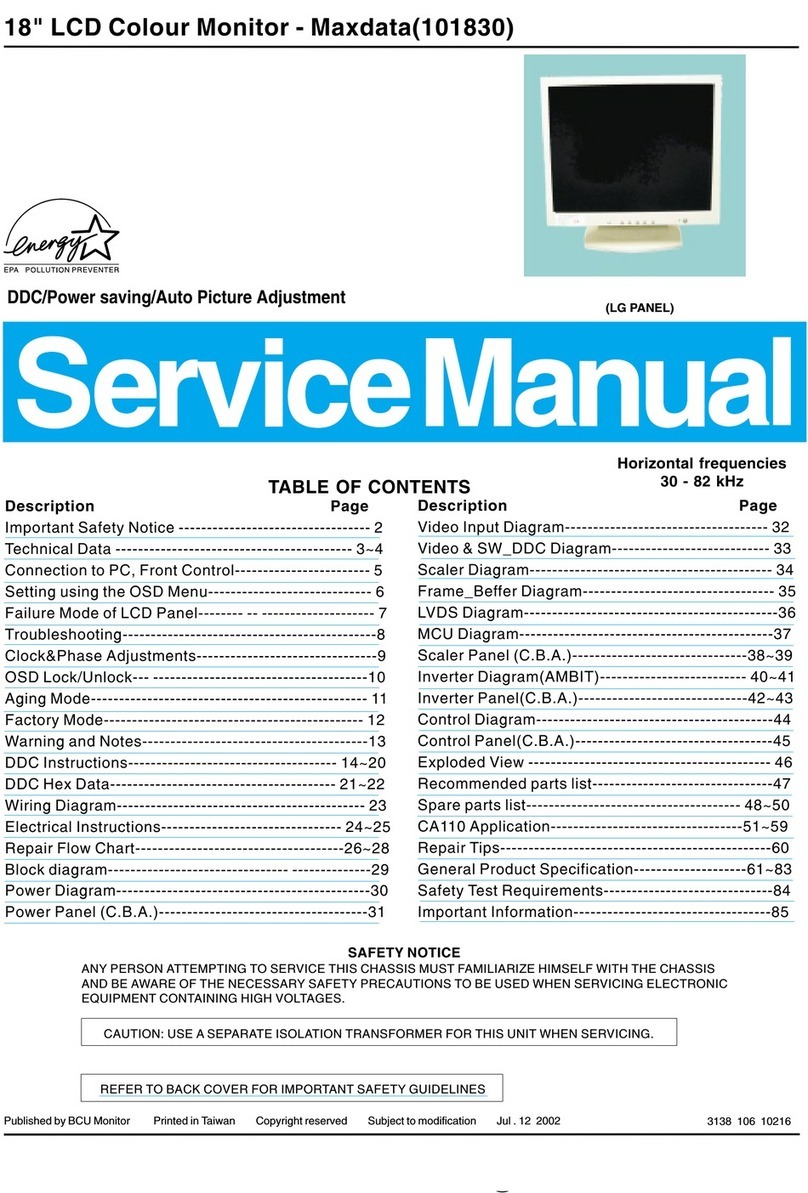
BELINEA
BELINEA 101830 User manual
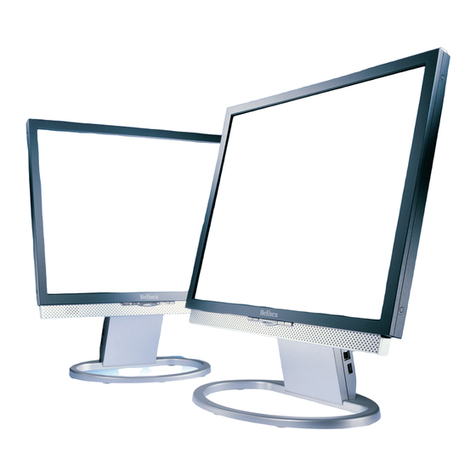
BELINEA
BELINEA Belinea 2025 S1W User manual

BELINEA
BELINEA 101710 User manual
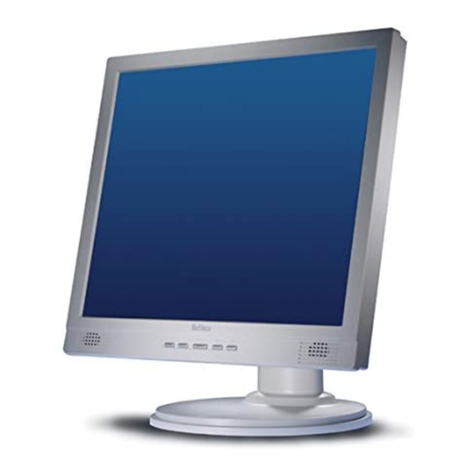
BELINEA
BELINEA 101915 User manual

BELINEA
BELINEA 101925 User manual
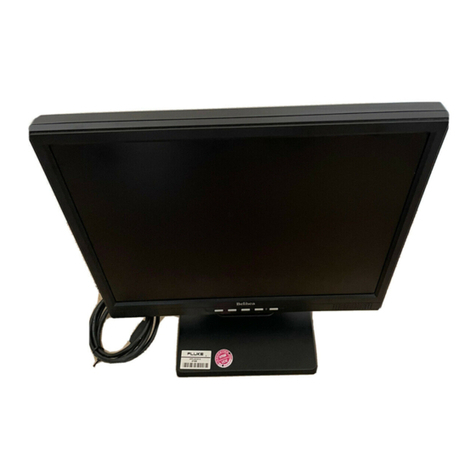
BELINEA
BELINEA 101711 User manual
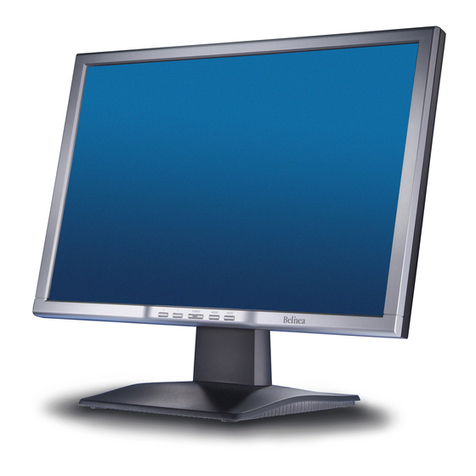
BELINEA
BELINEA 2225 S1W User manual
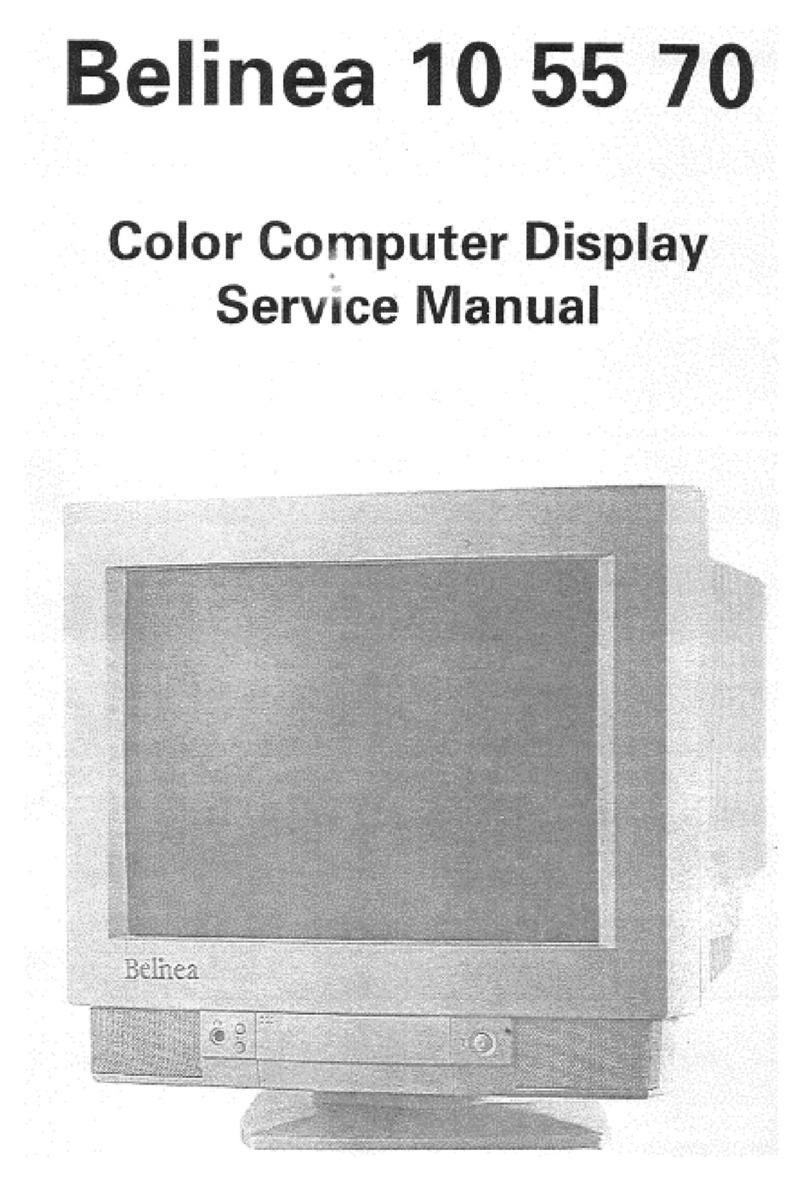
BELINEA
BELINEA 10 55 70 User manual

BELINEA
BELINEA 101555 User manual

BELINEA
BELINEA 10 17 10 User manual
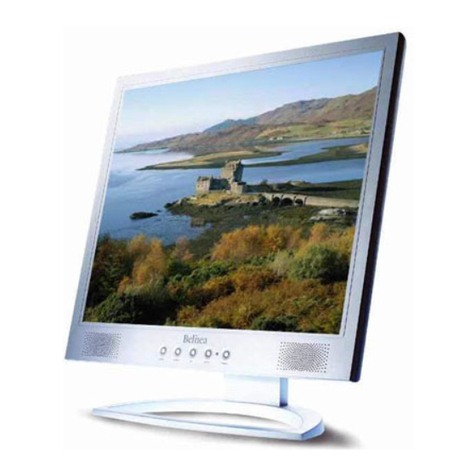
BELINEA
BELINEA 101903 User manual
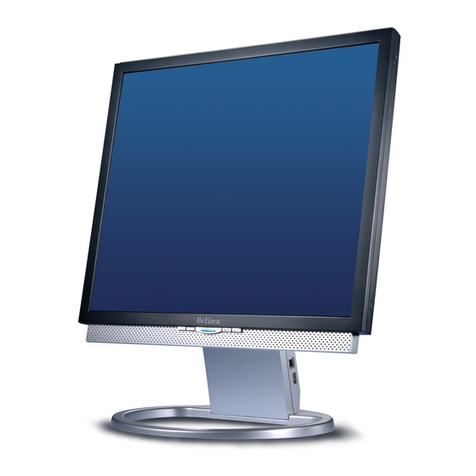
BELINEA
BELINEA 1975 S1 User manual

BELINEA
BELINEA 101901 User manual

BELINEA
BELINEA 2485 S1W User manual

BELINEA
BELINEA 10 30 55 User manual

BELINEA
BELINEA 101910 User manual
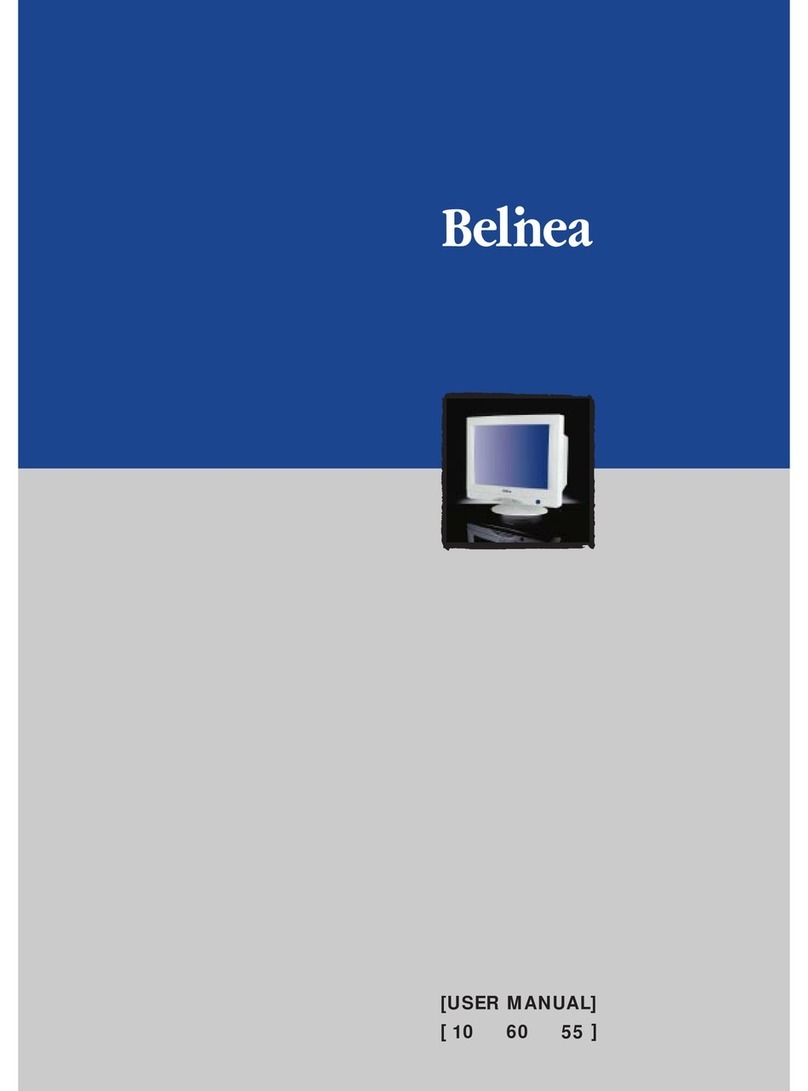
BELINEA
BELINEA 10 60 65 User manual

BELINEA
BELINEA 10 80 35 User manual

BELINEA
BELINEA 2080 S2 User manual

BELINEA
BELINEA 10 User manual


